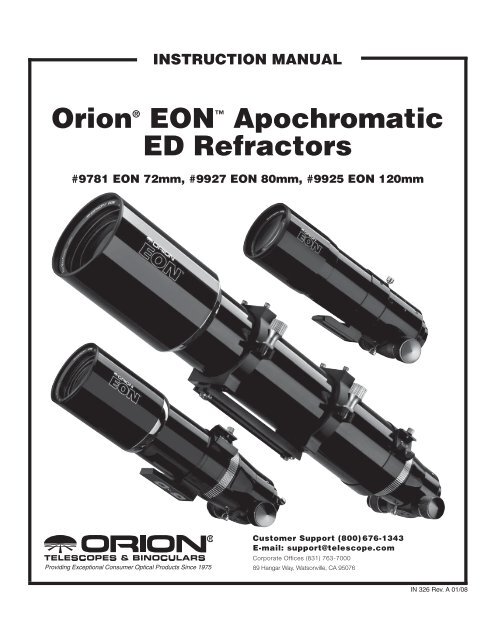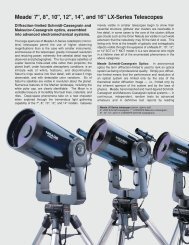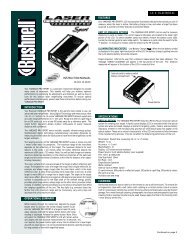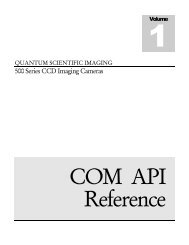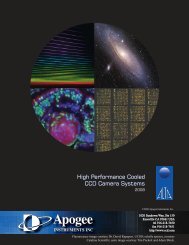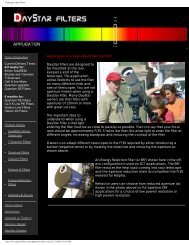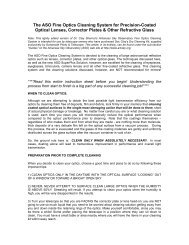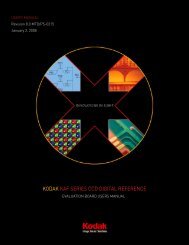orion® Eon⢠apochromatic ED refractors
orion® Eon⢠apochromatic ED refractors
orion® Eon⢠apochromatic ED refractors
Create successful ePaper yourself
Turn your PDF publications into a flip-book with our unique Google optimized e-Paper software.
instruction Manual<br />
Orion ® EON Apochromatic<br />
<strong>ED</strong> Refractors<br />
#9781 EON 72mm, #9927 EON 80mm, #9925 EON 120mm<br />
Providing Exceptional Consumer Optical Products Since 1975<br />
Customer Support (800) 676-1343<br />
E-mail: support@telescope.com<br />
Corporate Offices (831) 763-7000<br />
89 Hangar Way, Watsonville, CA 95076<br />
IN 326 Rev. A 01/08
Congratulations on your purchase of an Orion ® EON <strong>ED</strong> Apochromatic Refractor optical tube assembly. The<br />
exceptional optical and mechanical quality of your EON refractor will provide you with a pleasing telescope experience.<br />
The <strong>ED</strong> glass in the objective lens yields extremely sharp, high-contrast images with virtually no color distortion<br />
compared to a standard refractor. The smooth and fine movement of the dual-speed Crayford focuser allows<br />
for easy and precise focusing. These instructions will help you use your EON refractor optical tube assembly.<br />
Focus rotation lock ring<br />
(for EON 80mm only)<br />
2" Eyepiece<br />
holder<br />
Finder scope dovetail base<br />
(for EON 80mm only)<br />
Dew shield<br />
Tube rings<br />
Tube ring<br />
clamps<br />
Finder scope<br />
dovetail base<br />
1.25"<br />
Eyepiece<br />
adapter<br />
Coarse focus knob<br />
Mounting block<br />
Fine focus knob<br />
Dovetail mounting plate<br />
Figure 1a. The EON 72mm and 80mm <strong>ED</strong> Refractor optical<br />
tube assembly<br />
Parts List<br />
EON 72mm & 80mm<br />
Optical tube assembly<br />
Dust Cover<br />
1.25" eyepiece adapter<br />
2.5mm hex key<br />
Hard carrying case<br />
EON 120mm<br />
Optical tube assembly<br />
Dust Cover<br />
1.25" eyepiece adapter<br />
Tube rings (quantity 2)<br />
Dovetail mounting plate<br />
2.5mm hex key<br />
Hard carrying case<br />
Getting Started<br />
Your EON refractor is fully assembled from the factory. The<br />
optics have been installed and collimated, so you do not<br />
need to make any adjustments to them.<br />
We recommend keeping all of the original packaging. In the<br />
unlikely event you should need to ship the telescope back to<br />
Orion for warranty repair service, you should use the original<br />
packaging to ensure the telescope stays intact during<br />
shipping.<br />
Take a moment to inspect the telescope and all of its parts.<br />
Figure 1b. The additional features of the EON 120mm <strong>ED</strong><br />
Refractor optical tube assembly<br />
Functions and Features<br />
The EON <strong>refractors</strong> have several features designed to maximize<br />
the use and enjoyment of your telescope. When you<br />
have become familiar with all of the functions of your EON<br />
refractor, you will be ready to begin using your new telescope<br />
under the night sky!<br />
Retractable Dew Shield<br />
All EON <strong>refractors</strong> feature a retractable dew shield which<br />
allows the telescope to become more compact for storage.<br />
The dew shield’s primary purpose is to prevent dew<br />
(water condensation) from forming on the lens during cold<br />
and humid nights. The dew shield is also useful for reducing<br />
glare under unwanted outside lights. To extend the dew<br />
shield, remove the optical tube dust cover, then pull the dew<br />
shield outward until it stops (Figure 2).<br />
Figure 2. Gently pull the dew shield outward until it stops.<br />
2
2" Dual-Speed Crayford Focuser<br />
The high quality dual-speed 2" Crayford focuser is one of<br />
the most important components of your EON refractor. The<br />
Crayford design allows for smooth, precise focusing without<br />
any image shift that typical rack-and-pinion designs experience.<br />
For quick focusing of your EON refractor, the two larger<br />
focus knobs will provide a coarse focus. For more precise<br />
focusing, as needed for applications such as critical high<br />
power planetary observing and digital imaging, the smaller<br />
black focus knob (Figure 1a) offers fine focus adjustment.<br />
The fine focus knob rotates eleven times to one single rotation<br />
of the coarse focus knobs, making an 11:1 ratio for<br />
extremely precise focusing.<br />
The dual-speed Crayford is capable of handling the weight<br />
of heavy accessories, such as large 2" eyepieces or a CCD<br />
or DSLR camera. Adding tension to the focuser drawtube<br />
will further increase the amount of weight the focuser can<br />
handle without slipping. To adjust the focuser drawtube tension,<br />
locate the focus tension set screw on the underside<br />
of the focuser (Figure 3). Using the 2.5mm hex key, turn<br />
the set screw clockwise until you have added the appropriate<br />
amount of tension for your needs. In some cases, you<br />
may want to loosen the tension, which will also decrease<br />
the resistance of the focus knob movement. Simply turn the<br />
focus tension set screw counter-clockwise as needed to<br />
loosen the focus drawtube tension.<br />
Tightening the focus lock thumbscrew (Figure 3) will prevent<br />
the drawtube from moving. This feature can be utilized for<br />
imaging, or visual use, when you have achieved focus and<br />
do not want the drawtube to move. While you are focusing,<br />
make sure the focus lock thumbscrew is loosened, or the<br />
drawtube may not move properly.<br />
Note: Applying too little tension on the focuser will result in<br />
the focus drawtube to slide under its own weight, or under<br />
the weight of your accessories installed. Make sure there is<br />
enough tension to support your 2"or 1.25" accessories.<br />
Focuser Rotation<br />
The focuser assembly on the EON <strong>refractors</strong> have the ability<br />
to be rotated. Under normal use, you should not have<br />
to rotate the focuser, since the eyepiece and diagonal can<br />
be rotated instead. However, focuser rotation can be beneficial<br />
for changing the camera orientation while imaging<br />
(see “Imaging with the EON Refractors”). Additionally, this<br />
feature can allow you to keep the focus knobs parallel to the<br />
ground no matter how your telescope is positioned. This can<br />
be especially convenient when the telescope is mounted in<br />
different orientations, causing the focus knob orientation to<br />
change.<br />
To rotate the focuser, turn the focus rotation lock ring (Figure<br />
1a) counter-clockwise until the assembly loosens. Rotate the<br />
focuser to the desired orientation. Lock the focuser in place<br />
by turning the focus rotation lock ring clockwise. To ensure<br />
a secure lock, it is sometimes necessary to grab hold of<br />
the entire focuser assembly and firmly rotate it clockwise,<br />
bracing your other hand against the stationary portion of the<br />
optical tube.<br />
The 72mm EON refractor has screw holes for an optional<br />
finder scope dovetail base attached to the rotating portion<br />
of the focuser, allowing you to change the orientation of the<br />
finder scope as desired.<br />
The EON 72mm uses a single thumbscrew instead of a<br />
lock ring to lock the focuser rotation. To rotate the focuser<br />
on the EON 72mm, loosen the focuser rotation lock thumbscrew<br />
and rotate the focuser to the desired orientation. Lock<br />
the focuser in place by tightening the focuser rotation lock<br />
thumbscrew.<br />
Focus tension set<br />
screw<br />
Focus lock thumbscrew<br />
Figure 3. Adjustments can be made to the focus tension set<br />
screw using the provided 2.5mm hex key. Tightening the focus lock<br />
thumbscrew will stop the focuser drawtube from moving.<br />
Using 1.25" and 2" Accessories<br />
Your EON refractor can accommodate both 1.25" and 2"<br />
accessories, including just about any eyepiece, diagonal,<br />
or camera. The Crayford focuser has a 2" eyepiece holder<br />
with a 1.25" eyepiece adapter installed (Figure 4). Both the<br />
2" eyepiece holder and 1.25" eyepiece adapter feature a<br />
brass compression ring to hold your accessories in place.<br />
The brass compression ring securely holds the 1.25" or 2"<br />
accessory in place without marking its metal barrel.<br />
The telescope must be used with either a diagonal or extension<br />
tube in order for the eyepiece to reach focus. In most<br />
cases, you will be using a 90° star diagonal for visual use<br />
with an eyepiece.<br />
To attach a 1.25" diagonal or extension tube to your telescope:<br />
1. Remove the dust cap from the 1.25" eyepiece adapter.<br />
2. Insert the barrel of your diagonal or extension tube<br />
into the 1.25" eyepiece adapter.<br />
3
3. Secure the barrel in place by firmly tightening the<br />
thumbscrew on the 1.25" eyepiece adapter.<br />
To attach a 2" diagonal or extension tube to your telescope:<br />
1. Loosen the thumbscrew on the Crayford focuser’s 2"<br />
eyepiece holder and remove the 1.25" eyepiece adapter.<br />
2. Insert the barrel of your diagonal or extension tube<br />
into the 2" eyepiece holder.<br />
3. Secure the barrel in place by firmly tightening the<br />
thumbscrew.<br />
To insert a finder scope onto your EON refractor, slide the<br />
finder scope bracket into the finder scope dovetail base and<br />
secure it in place by tightening the thumbscrew(s) on the dovetail<br />
base (Figure 6).<br />
1.25" Eyepiece<br />
adapter thumbscrew<br />
2" Eyepiece<br />
holder<br />
thumbscrew<br />
Figure 6. Slide the finder scope bracket into the finder scope<br />
dovetail base and secure the locking thumbscrew(s).<br />
Brass compression ring<br />
2" Eyepiece holder 1.25" Eyepiece adapter<br />
Figure 4. The EON <strong>refractors</strong> accept both 1.25" and 2”<br />
accessories. The brass compression rings in the 1.25" eyepiece<br />
adapter and 2" eyepiece holder ensure a secure fit without marking<br />
up the barrel of your accessory.<br />
Finder Scope Compatibility<br />
The included finder scope dovetail base on the EON 80mm<br />
and 120mm <strong>refractors</strong> are ready to accept any Orion finder<br />
scope. The EON 72mm does not include a finder scope<br />
dovetail base; however, it is available optionally from Orion<br />
and directly fits the holes in the EON 72mm (Figure 5).<br />
Operating the EON<br />
Refractor<br />
Now that you have become familiar with the different features<br />
and functions of your EON refractor, you are ready to<br />
begin using your new telescope outside under a starry night.<br />
The EON <strong>refractors</strong> are essentially ready to begin observing<br />
with immediately. There is a small period of time where the<br />
internal temperature of the telescope must match the outside<br />
temperature to obtain the best image quality. This time<br />
period is nearly nominal, taking only a few minutes. Typically,<br />
the EON will have reached outside temperature by the time<br />
the telescope is setup.<br />
Holes for optional<br />
finder scope dovetail<br />
base<br />
Mounting<br />
block<br />
Dovetail plate<br />
1/4"-20 threads<br />
Figure 5. The EON 72mm is compatible with the Orion finder<br />
scope dovetail base.<br />
Figure 7. The EON 72mm and 80mm have a built-in mounting<br />
block ready to connect to a sturdy camera tripod or telescope<br />
mount.<br />
4
Connecting the EON 72mm and 80mm to a<br />
Tripod or Mount<br />
The EON 72mm and 80mm have a built-in mounting block<br />
ready to connect to a sturdy camera tripod or telescope<br />
mount (Figure 7). The mounting block is threaded to accept<br />
a common 1/4"-20 stud found on almost any camera tripod.<br />
To connect the EON 72mm or 80mm to a camera tripod,<br />
simply screw the 1/4"-20 stud found on your camera tripod<br />
to the underside of the EON’s mounting block. The EON<br />
72mm has three different holes to choose from, and the<br />
EON 80mm has two holes. Pick the 1/4"-20 hole that provides<br />
the best balance on your tripod.<br />
The mounting block also functions as a dovetail plate which<br />
is compatible with many Orion telescope mounts. The dovetail<br />
plate is also compatible with many other mounts. To connect<br />
the EON 72mm or 80mm to a telescope mount, loosen<br />
the attachment screw(s) on the mount’s dovetail holder until<br />
the screw(s) provides enough clearance for the dovetail<br />
mounting plate. Align the mounting block with the dovetail<br />
holder and slide it forward (Figure 8). Tighten the attachment<br />
screw(s) on the dovetail holder of the mount.<br />
when using heavy accessories, such as 2” eyepieces or<br />
DSLR cameras. To reverse the orientation of the mounting<br />
block, remove the screw (using a 4mm hex key) that<br />
attaches the mounting block to the telescope tube and turn<br />
it around 180° (Figure 9). Once the mounting block orientation<br />
has been reversed, reattach the screw.<br />
Figure 9. For a greater range of balance on the EON 72mm<br />
and 80mm, switch the direction of mounting block using a 4mm hex<br />
key.<br />
Figure 8. Align the mounting block with the dovetail holder and<br />
slide it forward. Tighten the attachment screw(s) on the dovetail<br />
holder of the mount.<br />
For the best stability and motion on your mount, the EON<br />
should be balanced front to back. If you are using the mounting<br />
block as a dovetail plate, then balancing the EON simply<br />
requires sliding the telescope forward or backward in the<br />
dovetail holder as needed. Loosen the attachment screw(s)<br />
on your mount just enough to free the dovetail plate, then<br />
reposition the telescope and retighten the screw(s).<br />
If you are using a camera tripod or telescope mount and<br />
need additional balance adjustment, the orientation of the<br />
mounting block can be reversed. This is especially helpful<br />
Connecting the EON 120mm to a Mount<br />
The EON 120mm refractor includes a preinstalled pair of<br />
tube rings and a dovetail mounting plate, ready to attach to<br />
a heavy-duty telescope mount. The dovetail plate is compatible<br />
with many Orion telescope mounts. The dovetail plate is<br />
also compatible with many other available mounts. To connect<br />
the EON 120mm to a mount, loosen the attachment<br />
screw(s) on the mount’s dovetail holder until the screw(s)<br />
provide enough clearance for the dovetail mounting plate.<br />
Carefully place the dovetail plate flat against the top surface<br />
of the dovetail holder of the mount and tighten the attachment<br />
screw(s) securely.<br />
Balancing the EON 120mm can be achieved by sliding<br />
the dovetail mounting plate forward or backward within the<br />
mount’s dovetail holder. You can also move the telescope<br />
forward or backward within the tube rings. The tube rings<br />
offer the most adjustment range. Loosen the tube ring<br />
clamps (Figure 1b) slightly and slide the telescope tube<br />
forward or backward as needed to reach optimum balance,<br />
then retighten the tube ring clamps.<br />
5
Using Different Eyepieces<br />
The EON <strong>refractors</strong> work well with virtually any 1.25" or 2"<br />
eyepiece. Because the EON <strong>refractors</strong> implement high-quality<br />
<strong>ED</strong> optics, the eyepieces you use should also have excellent,<br />
fully multi-coated optics to utilize the full performance<br />
of the EON. The diagonal used should also be a quality 90°<br />
mirror with high reflectivity.<br />
It is desirable to have a range of eyepieces of different focal<br />
lengths, to allow viewing over a range of magnifications. To<br />
calculate the magnification, or power, of a telescope, simply<br />
divide the focal length of the telescope by the focal length of<br />
the eyepiece:<br />
Telescope Focal Length (mm) = Magnification<br />
Eyepiece Focal Length (mm)<br />
For example, the EON 80mm <strong>ED</strong>, which has a focal length<br />
of 500mm, used in combination with a 25mm eyepiece,<br />
yields a power of 20x.<br />
500mm = 20x<br />
25mm<br />
If all outside viewing conditions are ideal, every telescope<br />
with good optics supports a maximum of about 60x per<br />
inch, or 2.4x per millimeter, of aperture. Keep in mind that<br />
at higher powers, an image will always be dimmer and less<br />
sharp (this is a fundamental law of optics). In most cases<br />
the steadiness of the air (the “seeing”) will limit how much<br />
magnification the scope can tolerate, rather than the telescope<br />
itself.<br />
Always start viewing with your lowest-power (longest focal<br />
length) eyepiece in the telescope. After you have located<br />
and observed the object with it, you can try switching to a<br />
higher-power eyepiece to ferret out more detail, if atmospheric<br />
conditions permit. If the image you see is not crisp<br />
and steady, reduce the magnification by switching to a<br />
longer focal length eyepiece. As a general rule, a small but<br />
well-resolved image will show more detail and provide a<br />
more enjoyable view than a dim and fuzzy, over-magnified<br />
image.<br />
Imaging with the EON Refractors<br />
The EON <strong>refractors</strong> make very capable astrographs for your<br />
CCD or DSLR camera. To attach a DSLR camera, all you<br />
will need is the appropriate T-ring for the make and model<br />
of your camera, and a 2" prime focus camera adapter (available<br />
from Orion). Simply attach the T-ring to the camera<br />
body and thread the 2" prime focus camera adapter into<br />
the T-ring. Insert the barrel of the camera adapter into the<br />
2" eyepiece holder on the EON focuser (Figure 10), and<br />
secure it with the thumbscrew.<br />
Most CCD cameras will have a 1.25" or 2" barrel ready<br />
to attach directly to your telescope like an eyepiece or<br />
diagonal. No adapter is required, simply insert the barrel<br />
of the CCD camera into the 1.25" or 2" eyepiece holder and<br />
secure the camera with the thumbscrew.<br />
The EON <strong>ED</strong> <strong>refractors</strong> were designed to reach focus with<br />
both DSLR and CCD cameras. However, every camera's<br />
focus point is a little different. Depending on your camera,<br />
you may need to use an extension tube for your particular<br />
imaging setup. Any imaging accessory, such as a color filter<br />
wheel, increases the amount of inward focus travel required.<br />
Before attaching any extra imaging accessory, try reaching<br />
focus first with the camera directly attached to the focuser,<br />
then see if you have enough inward focus travel left for extra<br />
accessories.<br />
DSLR<br />
2" Prime focus<br />
camera adapter<br />
Camera T-ring<br />
2" Eyepiece<br />
holder<br />
Figure 10. To attach a DSLR camera, attach the T-ring to the<br />
camera body, then thread the camera adapter to the t-ring. Insert<br />
the camera adapter barrel into the 2” eyepiece holder on the<br />
focuser and tighten the attachment thumbscrew.<br />
Imaging equipment is sometimes heavier than a diagonal<br />
and eyepiece. The dual-speed Crayford focuser is capable of<br />
handling the weight of your CCD or DSLR camera. Adding<br />
tension to the focuser drawtube will increase the amount of<br />
weight the focuser can handle. Install your camera onto the<br />
focuser during the day. Check the focuser for any slippage. If<br />
the focuser drawtube slips under the weight of the camera,<br />
you will need to add more tension to the focuser by tightening<br />
the focus tension set screw.<br />
Note About Chromatic Aberration<br />
Chromatic aberration literally means color distortion.<br />
Whenever light passes through one material to another,<br />
different wavelengths (color) are bent by different amounts.<br />
This is a problem that plagues refractor-type telescopes,<br />
since light passes through both air and glass to form an<br />
image. Most astronomical objects emit a spectrum comprised<br />
of many different wavelengths of light, so each<br />
wavelength will be bent by a slightly different amount when<br />
passing through a lens. This results in each color of light<br />
reaching precise focus at a slightly different point, which will<br />
provide a soft image with a halo of unfocused color.<br />
The EON is designed to minimize chromatic aberration. The<br />
objective lens is actually comprised of two individual lenses,<br />
the crown (front) element, and flint (rear) element. The EON<br />
features a flint glass element made of high-performance<br />
<strong>ED</strong> glass. The use of this <strong>ED</strong> glass minimizes the amount<br />
of chromatic aberration, resulting in a much more pleasing<br />
view as compared to <strong>refractors</strong> that do not have <strong>ED</strong> glass.<br />
Critical stellar or planetary observations become more accurate<br />
with this color correction since the focus is sharper with<br />
no unfocused “false” or unwanted color around the object.<br />
The <strong>ED</strong> optics will render true, high-contrast images.<br />
6
Care & Maintenance<br />
Give your telescope reasonable care and it will last a lifetime.<br />
When not in use, keep its dust cover on as well as the dust<br />
cap on the eyepiece opening. Keep the telescope inside the<br />
hard storage carrying case when not in use. Store it indoors<br />
or in a dry garage. Do not leave the telescope outside except<br />
when using it. The optical tube is aluminum and has a smooth<br />
anodized surface that should resist scratches and smudges.<br />
If a scratch does appear on the tube, it will not harm the telescope.<br />
Smudges on the tube can be wiped off with standard<br />
household cleaners.<br />
Dew<br />
When you are ready to pack up your telescope at the end of<br />
the night, avoid immediately storing it in the hard case if you<br />
encountered heavy dew and the telescope is damp. Instead,<br />
bring the telescope inside and allow the moisture on the telescope<br />
to evaporate. If dew forms on the objective lens, then<br />
leave the dust cover off of the telescope until all the moisture<br />
has evaporated. Once the telescope has completely dried out,<br />
place it in the hard case.<br />
Cleaning Optical Surfaces<br />
In general, your telescope will only need to be cleaned on a<br />
very minimal basis. Dust particles on the objective lens do not<br />
effect the optical quality of your EON. Loose dust can simply<br />
be blown off with air, using a compressed air can or blower<br />
bulb (available from Orion). Any remaining dust is best left<br />
alone, unless the build up is extreme. Finger prints and water<br />
marks should be cleaned from your telescope’s objective<br />
lens. Any quality optical lens tissue and cleaning fluid specifically<br />
designed for multi-coated optics can be used to clean<br />
the telescope’s objective lens as well as the lenses of your<br />
eyepieces and finder scope. Never use regular glass cleaner<br />
or cleaning fluid designed for eyeglasses. Before cleaning<br />
with fluid and tissue, however, blow any loose particles off the<br />
lens with a blower bulb or compressed air, or lightly brush the<br />
lens with a soft camel hair brush. Apply some cleaning fluid to<br />
a tissue, never directly on the optics. Wipe the lens gently in<br />
a circular motion, then remove any excess fluid with a fresh<br />
lens tissue. Oily fingerprints and smudges may be removed<br />
using this method. Use caution; rubbing too hard may scratch<br />
the lens! Clean only a small area at a time, using a fresh lens<br />
tissue on each area. Never reuse tissues.<br />
Specifications<br />
EON 72mm <strong>ED</strong> Apochromatic Refractor<br />
Optical tube:<br />
Seamless aluminum<br />
Objective lens:<br />
Apochromatic, rear element made<br />
of FPL-51 <strong>ED</strong> glass, air-spaced<br />
Objective lens coating: Fully multi-coated<br />
Lens cell:<br />
Machined aluminum<br />
Focal length:<br />
430mm<br />
Focal ratio:<br />
f/6.0<br />
Baffles:<br />
2 knife-edge baffles<br />
Focuser:<br />
Mounting:<br />
Weight:<br />
Length:<br />
Outside Diameter:<br />
Dual Speed 11:1 Crayford, accepts<br />
1.25" or 2" accessories, brass<br />
compression ring<br />
Mounting block, dovetail design,<br />
1/4"-20 threaded<br />
5.0 lbs./2.27 kg<br />
12.5"/31.75cm with dew shield<br />
retracted<br />
3.43"/87mm<br />
EON 80mm <strong>ED</strong> Apochromatic Refractor<br />
Optical tube:<br />
Seamless aluminum<br />
Objective lens:<br />
Apochromatic, rear element made<br />
of FPL-53 <strong>ED</strong> glass, air-spaced<br />
Objective lens coating: Fully multi-coated<br />
Lens cell:<br />
Machined aluminum<br />
Focal length:<br />
500mm<br />
Focal ratio:<br />
f/6.25<br />
Baffles:<br />
Cone baffle<br />
Focuser:<br />
Dual Speed 11:1 Crayford, accepts<br />
1.25" or 2" accessories, brass<br />
compression ring<br />
Mounting:<br />
Mounting block, dovetail design,<br />
1/4"-20 threaded<br />
Weight:<br />
6.5 lbs./2.95 kg<br />
Length:<br />
15.25"/38.74cm with dew shield<br />
retracted<br />
Outside Diameter: 3.54"/90mm<br />
EON 120mm <strong>ED</strong> Apochromatic Refractor<br />
Optical tube:<br />
Seamless aluminum<br />
Objective lens:<br />
Apochromatic, rear element made<br />
of FPL-53 <strong>ED</strong> glass, air-spaced<br />
Objective lens coating: Fully multi-coated<br />
Lens cell:<br />
Machined aluminum<br />
Focal length:<br />
900mm<br />
Focal ratio:<br />
f/7.5<br />
Baffles:<br />
3 knife-edge baffles<br />
Focuser:<br />
Dual Speed 11:1 Crayford, accepts<br />
1.25" or 2" accessories, brass<br />
compression ring<br />
Mounting:<br />
Tube rings and dovetail plate<br />
Weight:<br />
14.31 lbs./6.49 kg<br />
Length:<br />
31.25"/79.38cm with dew shield<br />
retracted<br />
Outside Diameter: 3.54"/122mm<br />
7
One-Year Limited Warranty<br />
The Orion EON Refractor is warranted against defects in materials or workmanship for a period of one year<br />
from the date of purchase. This warranty is for the benefit of the original retail purchaser only. During this warranty<br />
period Orion Telescopes & Binoculars will repair or replace, at Orion’s option, any warranted instrument<br />
that proves to be defective, provided it is returned postage paid to: Orion Warranty Repair, 89 Hangar Way,<br />
Watsonville, CA 95076. Proof of purchase (such as a copy of the original receipt) is required.<br />
This warranty does not apply if, in Orion’s judgment, the instrument has been abused, mishandled, or modified,<br />
nor does it apply to normal wear and tear. This warranty gives you specific legal rights, and you may also have<br />
other rights, which vary from state to state. For further warranty service information, contact: Customer Service<br />
Department, Orion Telescopes & Binoculars, 89 Hangar Way, Watsonville, CA 95076; (800) 676-1343.<br />
8


